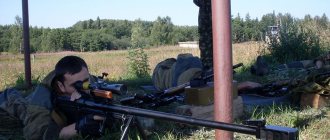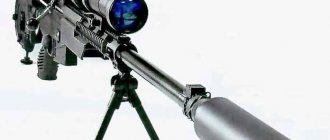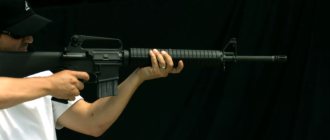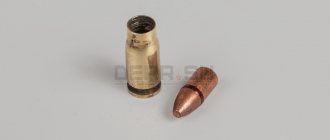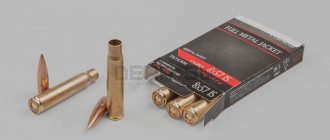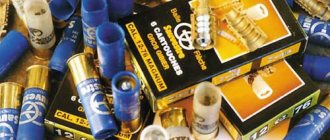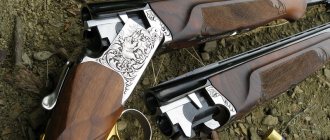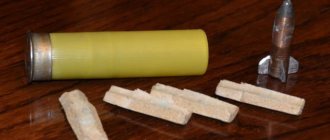Bullet Bison and Arrow 12, 16, 20 and 410 caliber.
Russian developer and manufacturer of bullets since 1989. Krasnozavodsk Chemical Plant (enterprise of the military-industrial complex). He also uses the “Strela” bullet as a standard cartridge for smooth-bore weapons under the “Record” brand.
The bullet projectile consists of:
- “Strela” bullets, which are solid without internal cavities. Externally, the bullet resembles an aircraft bomb (a massive round head and six tail fins) and has an arrow-shaped profile (profile). When fired at the moment of passage of the bore and upon impact, the body of the bullet is practically not deformed and the bullet retains good ballistics for the entire flight until it meets the target.
- two polyethylene separable semi-cylindrical shells, in which there is a Strela bullet of 12,16,20 caliber. A 410 caliber Strela bullet is placed in a container.
The dispersion diameter of this bullet at a distance of 50 m is 15 cm. This value has been confirmed by dozens of shootings of this bullet, the results of which are posted on the Internet on hunting forums. There are practically no negative reviews for this bullet. Its only drawback that is noted is its tendency to ricochet off branches, which is typical for all arrow-shaped bullets.
The bullet has excellent stopping power and is good for hunting large wild boar, elk, and bear.
This is a lead analogue of Rubeykin’s brass bullet, which weighed 32 grams. Bison bullet weight - 42 gr.
The manufacturer of the Bison bullet is the Krasnozavodsk Chemical Plant. This bullet is chambered in Record cartridges - 12 gauge.
A bullet projectile consists of: a lead bullet and a polyethylene container (two half-shells in which the bullet body is sandwiched).
The bullet is solid - without internal hollow holes. This minimizes its deformation as at the moment of passage of the bore. and when hitting the target. The large weight of the bullet (one of the heaviest) and the blunt head provide a good stopping effect when hunting large animals.
Bison - has good accuracy, ensuring reliable hit of a target at a distance of 50 m.
Our bullet measurements:
1) diameter along the leading belts (this is the largest diameter by which you need to check the passage of a bullet through the choke) - 16.6 mm. 2) leg diameter - 9.8 mm. 3) bullet length - 23.0 mm. 4) head band - 7.8mm. 5) head band + cone - 14.3 mm. 6) tail band - 2.2 mm. 7) tail band + cone - 5.2 mm. leg length - 3.5mm.
2) leg diameter - 9.8 mm. 3) bullet length - 23.0 mm. 4) head band - 7.8mm. 5) head band + cone - 14.3 mm. 6) tail band - 2.2 mm. 7) tail band + cone - 5.2 mm. leg length - 3.5mm.
Weight data for the loaded Bison bullet (Record cartridge), weighing on electronic scales with an error of 0.001 g:
- bullet weight - 41.55 g. (manufacturer indicates 42 g).
- bullet weight in container - 44.22g.
Photo gallery of Bison bullets
You can buy Strela and Bison bullets of 12, 16, 20 and 410 caliber in Moscow in the VSP online store with delivery to any location.
Arrow-shaped bullets: a path of false hopes or a story of missed opportunities? Part 1
Designers have always faced the requirements for improving small arms.
Even though the current level often seemed to have reached the limit of its development. For example, the Russian “Artillery Journal” in No. 4 for 1857 wrote that “small arms have reached such perfection that, apparently, nothing more can be expected from them...” But after some time, thanks to the advent of smokeless powder and metal cartridges with the central firing capsule, the last qualitative (revolutionary) leap in modern history occurred, thanks to which cartridges and small arms reached their modern level of development. But what to do next, what ideas or inventions can provide a fundamental improvement in what has been achieved? Obviously something new is needed. But it is also obvious that, in addition to searching for new solutions, it is necessary to know and understand the experience of previous generations well. So as not to reinvent the wheel and repeat the mistakes of others. And maybe take a closer look at some old ideas if they're worth it.
Among the experimental works of the recent past, one of the most promising and promising was the development of cartridges with feathered sub-caliber bullets for small arms, which were carried out for quite a long time both here and abroad. One of the authors of Western studies, Irvin R. Barr, was madly in love with the concept of sub-caliber. And in domestic industry documents from the mid-70s, these developments were given the status of “the most important and promising direction.” But cartridges with FPP (feathered sabot bullets) were never adopted for service either here or abroad. So what was it, why didn’t it take off? This article is devoted to the subject and history of these developments and is largely based on data from the monograph “Combat Cartridges for Small Arms” by Vladislav Nikolaevich Dvoryaninov.
It is necessary to begin the presentation by explaining the basic reasons for such close interest. The figure shows diagrams of a shot with a sub-caliber bullet (left) and the classic, “caliber” version. The sub-caliber bullet (1) is made in the form of a feathered arrow. Its diameter is less than the caliber of the barrel (3) and therefore it is called sub-caliber. The arrow-shaped bullet shape was chosen because it is stabilized in flight by its feathering, and not by rotation, as we are used to. Because to give it the rotation required by ballistics, it needs such a steepness of the rifling that it turns the barrel practically into a nut... The second most important structural detail is a light pulling ring (2), which is connected to the bullet. In practice, it received the established name “pallet”, which we will use in the future. The pan perceives the pressure of the powder gases (4) with the entire cross-sectional area “S1” and can accelerate together with the bullet to significantly higher speeds than a classic caliber bullet (5, right) of the same weight, but with a smaller area “S2”. After leaving the barrel, the pan is separated and the bullet continues its flight to the target on its own. Thus, the sub-caliber design makes it possible to achieve an improvement in all ballistic parameters of the shot, which, with comparable dimensions of cartridges and caliber, leads to a noticeable increase in the direct shot range (DPV) with a reduced recoil impulse, but at the same pressure of the powder gases.
Any specialist, having assessed such capabilities of the sub-caliber scheme, should really be delighted. But I must immediately think: how, in one way or another, to first ensure a reliable connection between the pallet and the bullet when moving in the barrel, and then their easy and reliable separation? And he will be right, because this is the key to the practical implementation of the whole idea.
In the USA, Irwin Bare's colleagues, whose experimental cartridges from the 1954 patents are shown in the photo, relied on guiding the bullet with a solid pan due to the frictional forces that arise when the pan is compressed by powder gases and separated from the bullet due to the destruction of the muzzle nozzle by knives. At the same time, based on the recommendations of the Combat Operations Research Department (ORO) to improve the effectiveness of handguns, they chose for development a version of a cartridge in 5.56 mm caliber with a light (0.65 g) but very high speed (Vо = 1430 m /c) a feathered sub-caliber bullet, which, according to their calculations, provides sufficient destructive power at the required ORO engagement distances, as well as a low recoil impulse: from 0.30 to 0.18 kgf*c.
Domestic research on feathered sub-caliber shells began in the USSR back in 1946 (by artillerymen). In 1960, an armor-piercing OPS for the 100-mm smooth-bore Rapier T-12 anti-tank gun was adopted. Influenced by the success of this work in 1960, the group of A.G. Shipunov at NII-61 carried out a theoretical assessment of the possibility of using a similar design for projectiles of aircraft automatic guns. At the same time, a domestic project began to create a new 5.45 mm rifle complex. Therefore, Shipunov proposed working on the idea of sub-caliber ammunition in relation to small arms cartridges (and not under the influence of “intelligence data,” as some “experts” erroneously indicate). V.P. took part in the development of the general idea. Gryazev, who in the previous 1959 was one of the performers of research work on studying foreign experience in the development of new small-caliber systems (as a gunsmith). The preliminary design of the cartridge was entrusted to D.I. Shiryaev, who “didn’t spend a full day on this.”
The final proposal was a cartridge with an OPP, a recoil impulse of 0.5 kgf s with a smooth barrel caliber of 8.0 mm. The authors considered the proposed method of connecting the pallet and the sub-caliber bullet to be the highlight, the fundamental novelty. They wrote: “ We know about the existence of sub-caliber mines with detachable pallets... We only claim a new form of performing a sub-caliber shot, and not a sub-caliber shot as a whole... The creation of a small-caliber sub-caliber feathered bullet... became possible only after we found a way fastening the pallet to the bullet due to frictional forces formed when the sectors of the pallets are compressed by gases..."
For which a corresponding copyright certificate was later issued. Below is the original drawing for this application and a photograph of the first version of the arrow-shaped bullet made according to it.
An attentive reader, by the way, may puzzle over the question: how, according to this drawing, was it supposed to secure the cartridge case in the chamber of the weapon?
The technology part of the proposal may at first seem boring and tedious with details. But its unconventionality, to put it mildly, is interesting and deserves attention. The pallet blank in the form of a duralumin tube with longitudinal cuts (to ultimately obtain a multi-sector pallet) was first supposed to be “pressed tightly onto an arrow-shaped bullet.” Then, once assembled, grind the central and tail parts of the tube. After this, cartridge the entire sleeve assembly, and in this form, together with the sleeve, grind the head part of the tube, ultimately obtaining ready-made sectors of the pallet. Then the cartridge would be loaded with gunpowder through a hole in the bottom of the cartridge case, where the sleeve with the primer or the capsule itself would eventually be pressed in... Ballistic calculations were also made, but for them an unattainably good ballistic coefficient of the future sub-caliber bullet (1.9 m2/kgf) was accepted according to Siacci), which led to fantastically good calculation results for trajectory flatness and bullet energy at typical firing ranges. Based on all of the above, Shiryaev prepared appropriate posters and a general presentation of the idea. Which the bosses really liked. As a result, Dmitry Ivanovich Shiryaev was temporarily transferred to cartridge department No. 23 in mid-1960 for the practical implementation of the proposed idea. Where he worked in the cartridge direction until the end of 1961. The short participation of one of the initiators is explained by the fact that during the very first experiments it became clear that none of the original proposals were suitable. It was not possible to achieve the correct functioning of the shot - the pallets were torn off the boom in the barrel even at half the design value of the maximum pressure of the powder gases. At first, we had to abandon pressing the pallet blank onto the boom and its step-by-step turning, small semicircular grooves on the boom and, most importantly, the use of friction forces to connect the boom and the pallet. We tried to use metric threads to connect the sectors of the pallets and the bullet, but this also did not produce results. The measured ballistic coefficient of the first swept bullets turned out to be 4.5 m2/kgf instead of 1.9 m2/kgf.
Despite the obvious failure of the first experiments, the patron group continued research. In those years, the group consisted of young cartridge engineers I.P. given to help Shiryaev. Kasyanova, O.P. Kravchenko and, later, V.A. Petrov (each of whom later became a laureate of USSR State Prizes for various works).
All elements of the cartridge were redesigned. Two options for thin-walled sleeves have appeared. The shape of the bullet and pallets have changed noticeably. For their reliable adhesion, a “comb” was already used, like artillery OPS. The smooth barrel caliber was changed to 7.62 mm. All elements of the booms and pallets were manufactured in pilot production using the methods of turning, milling and metalworking; the cartridges were assembled almost by hand. Aluminum pallets were made in pairs, without the possibility of their mutual replacement. As a result, the developers managed to achieve certain progress and ensure the normal and stable functioning of the shot, approaching the design values. The following photo shows mock-ups of experimental 7.62/3-mm cartridges from 1963-64.
The most important question at this stage of work was to determine to what extent sub-calibers meet the requirements for a promising weapon system. The most disappointing results were the tests at the end of 1962 on the lethal effect of arrow-shaped bullets, which turned out to be unacceptably low and significantly inferior to both standard cartridges and the future requirements of the military.
A little earlier, in May and June 1962, the Rzhev test site presented the conclusion “ The fundamental acceptability of a cartridge with a feathered sub-caliber bullet from the point of view of the safety of firing bullets with a flying pallet and the absence of special bullets in the ammunition
"
This conclusion is of exceptional importance, since in the entire subsequent history of the development of cartridges with OPP, it remained the only one in which the issue of sector expansion was studied comprehensively. Conducted by a highly qualified specialist, an officer of the Rzhev training ground, Ph.D. M.S. Shereshevsky, this study included not only determining the danger of sectors of pallets at different distances from the shooter, but also contained a detailed analysis of the possibility of finding friendly fighters in the expansion zone. It was shown that their presence in the danger zone, at small lateral distances from the firing trajectory, is prohibited and unlikely, since such a position of the fighter is very dangerous for him, regardless of what cartridges are fired. If such a presence can occur, then in very rare cases and at a distance of 25-30 meters from the shooter, where the sector no longer posed a danger. On the basis of which a fundamentally important conclusion was made that “ firing with feathered sub-caliber bullets is safe for friendly troops
.”
In 1963, the debugging of a prototype of the AO-27 assault rifle chambered for OPP cartridges, which was developed by D.I., was completed. Shiryaev, V.S. Yakushchev and Yu.G. Marychev. In terms of the energy of the moving parts, the AO-27 assault rifle was practically no different from the AKM assault rifle. But “ in the process of testing a prototype of the machine gun, it was revealed that the metal of the tray (aluminum alloy D16T) intensively sticks to the surface of the barrel bore when conducting automatic fire... When more than 150 shots are fired, bullets come out of the barrel bore with large nutation angles and with sharp departures from the average trajectories
" This effect could not be completely eliminated quickly using the method of anodizing the pallets. Therefore, after every 60-65 shots, it was necessary to clean the bore of the machine gun with a 20% alkali solution heated to 90 degrees. C, and its exposure for a sufficiently long time in the barrel bore, plugged from the muzzle with a rubber stopper. Despite this, the dispersion of shots during automatic firing was, to put it mildly, very large.
Based on the results of all the tests carried out, the Rzhev test site gave a very positive assessment of the potential of cartridges with OPP. Particularly noted was the achieved DPV with a recoil impulse of 0.5 kgf·s, unattainable for classical cartridges with caliber bullets. At the same time, when recommending that work be continued, very strict requirements for improvement were formulated:
1. Significantly increase the damaging and stopping effects of arrow-shaped bullets. 2. Ensure accuracy of firing with single shots at the level of standard ammunition. 3. Develop special, primarily tracer bullets.
The requirements listed above fully reflected the “natural shortcomings” of the sub-caliber design for small arms cartridges.
Work on cartridges with OPP was carried out as part of research work to create a new automatic low-pulse cartridge, and not for the sake of the beauty of the idea itself. In this main direction, by the end of 1964, very significant progress had already been achieved. Tests have confirmed that the experimental 5.45 mm cartridges practically meet the requirements in terms of accuracy, lethal, stopping and penetrating effects. Therefore, the “caliber” version outperformed the swept version, as they say, with a clear advantage. Including due to its “classical” manufacturability. Therefore, since the end of 1964, research on “automatic” 7.62/3 mm cartridges with OPP was practically stopped.
But patrons were haunted by the potential advantages of the sub-caliber design. Moreover, they were achieved in practice and many of the design nuances have already been studied. It was also clear that the identified deficiencies were very complex and possibly insurmountable problems. But they can only be solved by continuing intensive research.
In mid-1964, based on his own experience of working on the topic, I.P. Kasyanov and V.A. Petrov carried out preliminary design and calculation of the ballistic characteristics of not a machine gun, but a machine gun-rifle cartridge with a feathered sub-caliber bullet: smooth bore caliber 10 mm, bullet diameter 4.5 mm, bullet weight 4.5 grams, initial speed 1300 m/s. Calculations showed that the proposed cartridge should be superior to standard domestic and foreign rifle cartridges. It was also expected that the lethal effect of the 4.5 mm arrow-shaped bullet would be at the proper level, as it is heavier and larger.
The customers approved this direction of work and agreed on the technical specifications, the main conditions of which were a direct shot range of at least 600 m, lethal effect and accuracy of fire with single shots - no worse than a standard rifle cartridge with an LPS bullet. Thus, domestic work on cartridges with sub-caliber feathered bullets moved from the “weight category” of machine guns to machine guns and rifles.
Since 1965, Vladislav Dvoryaninov, a young specialist, a graduate of LVMI in 1960, who by that time had already become a leading design engineer and had some experience in working on “machine gun and rifle” topics, was appointed responsible for this cartridge since 1965.
When designing the first version of the 10/4.5 mm cartridge, previous experience was fully used. Double-section pallets were still made of aluminum alloy. The cartridge case was made from a semi-finished standard rifle cartridge case. The steel feathered sub-caliber bullet had a “comb” for adhesion to the sectors of the pallet.
But experimental shooting showed that the natural shortcomings of the sub-caliber scheme are still inherent in this option, and that they could not be solved by changing only the dimensions: the lethal effect of 4.5 mm arrow-shaped bullets was significantly inferior to the LPS bullets of the standard cartridge; The accuracy of firing single shots according to linear characteristics was 2-2.5 times worse than the standard. If we add to this the need to develop manufacturing technologies for all cartridge elements suitable for mass production, as well as the task of developing tracer bullets, then the enormous amount of work that had to be done becomes clear.
The further history of domestic work in this area, which lasted until 1983, is extensive and multifaceted. A detailed description of all the work would require too much volume, so we will limit ourselves to only the most fundamental points, without strictly observing the chronology of events.
Throughout the initial phase, repeated attempts were made to use a variety of types and brands of plastics for the pallet sectors. But all of them did not meet the requirements of maintaining adequate size and weight of pallet sectors. Until in 1970, on the initiative of patrons, a connection was established with the Vladimir Research Institute of Synthetic Resins, where a new type of resin was developed. As a result, pallet sectors began to be made from it. A technology for casting finished pallet sectors has been developed, suitable for use in automatic rotary lines for the industrial production of cartridges. The next photo on the left shows the sectors of the “old” pallets made of D16T alloy, in their final design with plastic belts. Shown on the right are the finished plastic pallet sectors, obtained directly from casting and requiring no further processing.
Technologically, the most labor-intensive and responsible was the production of arrow-shaped bullets with a given accuracy. It should be noted here that rumors about supposedly jewelry requirements for the accuracy of manufacturing arrow-shaped bullets are incorrect. In fact, the tolerance fields, according to the requirements of the drawing, were quite standard. For artillery BOPS, for example, similar requirements are much stricter, despite the significantly larger sizes of projectile elements and pallet sectors. During the work, a variety of methods and technologies for manufacturing arrow-shaped bullets were investigated. The following photograph shows samples of their semi-finished products obtained in different ways.
On the left - with a deep hole in the tail (tracer version of the bullet) was completely produced by cold stamping. In the middle – the head part is obtained using the radial cutting method. On the right - rotary forging using technology used in the manufacture of industrial sewing needles. Later, the Tula Polytechnic Institute completed the development of an original radial stamping device (RSD) for a press used in industry enterprises, which was distinguished by increased productivity with the required manufacturing accuracy. This, in principle, finally resolved the issue of mass production of arrow-shaped bullets. For this work, the team, which included employees of TPI and TsNIITOCHMASH, was awarded the prize to them in 1987. S.I. Mosin.
But the most significant and important were the studies on the very “natural shortcomings” of the sub-caliber scheme, without solving which everything else would not make much sense.
It was possible to fundamentally improve the destructive effect due to the design of the bullet. A flat was made on its head, thus ensuring its asymmetry and, accordingly, the occurrence of a tipping moment when the bullet is inserted into dense tissue. On the body of the arrow, in the area of the comb, a weakening element was made - a transverse groove or groove along which the arrow was bent under the influence of this overturning moment. According to the results of subsequent field tests, the 4.5-mm arrow-shaped bullets modified in this way showed better or equivalent damaging and stopping effects to LPS bullets. The penetrating and penetrating effect of arrow-shaped bullets never raised questions and satisfied the requirements, exceeding the standard ones.
The most difficult task was to perfect the accuracy of fire to the level of a standard rifle cartridge with an LPS bullet. The main reasons for the large dispersion were clear to the designers. This is the negative impact of the pallet sectors separating from the arrow when leaving the barrel channel and increased nutation angles of the arrows when leaving the barrel. At one time during the work, it seemed that the optimal solution had been found: an experimental version of a sub-caliber bullet with a plastic tail consistently showed good results, meeting the standard for accuracy at 100 and 300 meters with a margin.
But when shooting at long ranges, it suddenly became clear that there was a significant and unstable increase in the flight time of the bullets, and the holes in the shield were unacceptably oval. Which was unacceptable and indicated a significant deterioration in the form factor. The reasons, of course, were found. They turned out to be different and complex. A persistent search for a solution did not lead to success and we had to return to developing a version with a steel tail. In 1981, 10/4.5 mm 19VLG cartridges of batches OP 02-81-61 and OP 03-81-61 (for field tests), when submitted to the TsNIITOCHMASH Quality Control Department, showed accuracy of fire at 300 m from an R50sr ballistic barrel. = 8.8 and 8.9 cm, respectively (with the standard R50av. ≤ 9.0 cm).
Of course, this was the best that the developers could present at that time, but the required and so desired result was still achieved. And it was not accidental.
The ending follows...
© Nikolay Dvoryaninov, December 2022. Photos and drawings: Nikolay Dvoryaninov. Published: Kalashnikov Magazine, No. 12/2017.
